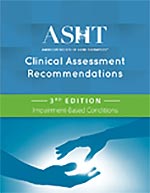Clinical Assessment Recommendations, 3rd Edition

ASHT's Clinical Assessment Recommendations, 3rd Edition was a project that was first pursued by ASHT in 1981, with a second edition published in 1992. Both editions have been widely utilized by clinicians around the world.
Clinical Assessment Recommendations, 3rd Edition. was developed by a number of therapists across the globe, taking a monumental effort to bring to fruition. Funds from the American Society of Hand Therapists Vision Fund supported the completion of this resource. We express our sincerest gratitude to everyone who had a hand in completing this very important project.
Quantifying function and activity participation in a systematic and reproducible manner is essential both in research and daily practice. Hand therapists must assess the client's baseline physical status using reproducible, standardized tools and methods to ensure the validity, reproducibility and accuracy of the data they collect. A vital component of hand therapy evaluation is the assessment of function in activities of daily living, work and leisure to identify areas of limitation. The use of valid assessment tools and measures can determine functional status, play a role in determining process and assist with goal setting.
The third edition of the Clinical Assessment Recommendations contains printed chapters, which cover materials unlikely to require frequent updating, such as assessment of edema, grip, pinch, pain, range of motion and sensibility.
CAR also includes digital chapters, which cover the body of evidence on outcome measures and diagnosis-specific assessments, such as those related to the osteoarthritic hand, sympathetic function, tendon repairs, the burned hand, manual strength testing and presenteeism. The online component also includes expanded content from the chapters printed in the book, including reliability and validity data, additional testing techniques and extensive photo guides. This includes topics that are still seeing developments, and so may need to be updated over time. The expanded content in the digital book includes figures and tables, and more detailed testing techniques. A full list of the chapters can found below:
Contents
Chapter 1: Grip
Includes detail of dynamometry and the maximal grip strength test, with an assessment of grip strength instruments, an overview sincerity of effort testing and detailed grip strength data for various populations in the online companion.
Chapter 2: Pinch Strength Dynamometry
Print edition includes color photos to guide administering this exam, while the online companion includes a more in-depth evaluation of pinch strength measurement and data studies.
Chapter 3: Sensibility
Print edition covers the Touch/Pressure Threshold Test, Two-Point Discrimination Test, Localization Test and more, with reliability, validity and responsiveness data outlined in the online companion.
Chapter 4: Measurement of Edema in the Hand Clinic
Print edition includes Volumetry and Figure-of-Eight Method and Circumferential Measurement, with reliability and validity data outlined in the online companion.
Chapter 5: Pain
Print edition outlines various methods for testing and evaluating pain, while the online companion includes responsiveness, reliability and validity data.
Chapter 6: Goniometry
Print edition details determining ROM using the universal goniometer, with additional methods, data and extensive photo examples included in the online companion.
*Chapter 7: The OA Hand
Includes measure for evaluating people with OA of the hand, including grip strength data.
*Chapter 8: Manual Strength Testing of the Muscles of the Hand and Wrist
Details various evaluations for MMST, along with photos and figures to guide evaluation.
*Chapter 9: Hand Function after Burn Injury
Outlines classification of burns as well as data and information regarding healing times and problems encountered after hand burns.
*Chapter 10: Sympathetic Function
Details methods to evaluate nerve injury and recovery.
*Chapter 11: Outcomes Following Tendon Repair
Includes outcomes assessment formulas and rating systems.
*Chapter 12: Presenteeism
Details various presenteeism scales to measure a worker’s perception of pain, along with reliability and validity data.
*Chapter 13: Clinical Assessment Recommendations for Patient-Reported Outcome Measures (PROMs)
Describes commonly used self-reported outcome measures for wrist and elbow conditions with a focus on scope, testing methods and clinical utility as well as measurement properties in specific populations.
*Chapter 14: WOUNDS: Healing, Assessment, Wound Care Treatment and Dressing Types
*Available only in the online companion.
To purchase Clinical Assessment Recommendations, 3rd Edition, please visit the ASHT store.

